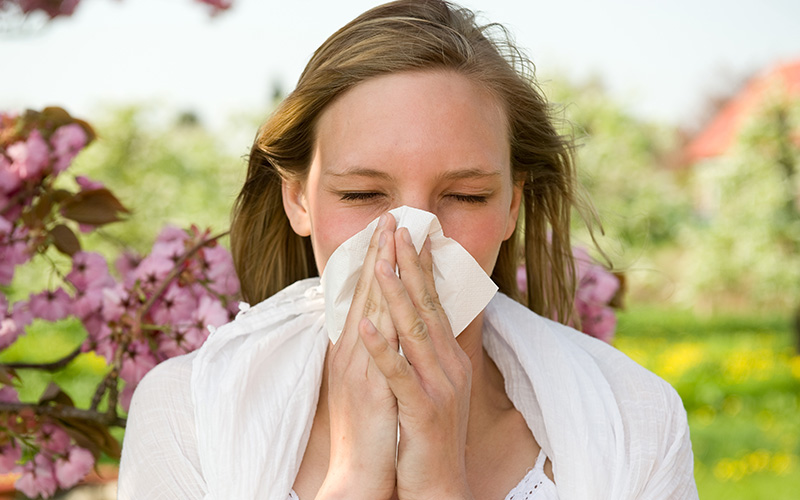
As spring brings warmer weather our way and plants begin a new year of growth, many people will find themselves experiencing the symptoms of seasonal allergies. If you are one of those allergy sufferers, you may be wondering what causes allergies and what you can do to prevent or manage the symptoms.
What causes allergies?
An allergy is a condition that has both hereditary and environmental factors. On the hereditary side, you can inherit a tendency to develop an allergy to a particular substance. On the environmental side, your body can react to substances you encounter in your home, inside other buildings, or outdoors.
Allergies occur when your immune system responds to substances (known as allergens) and triggers an allergic reaction. When your body comes into contact with an allergen, it releases chemicals such as histamine into your bloodstream. Histamine helps your body eliminate the allergens, and it is this process that causes symptoms such as itching, sneezing, watery eyes, and hives.
There are a number of allergens that trigger allergic reactions. Common ones are:
- Animal dander comes from pets. Pets with fur or feathers can shed flecks of dead skin, and these particles can float in the air in your home and cause you to experience an allergic reaction.
- Dust mites are tiny bugs that can collect on soft furnishings and household items such as pillows, mattresses, carpets, and children’s stuffed toys, where they can be easily breathed into your body.
- Mould is a type of fungus that results from high humidity levels and excessive water. Mould is most commonly found in poorly ventilated bathrooms and basements.
- Pollen is a powdery substance produced by grass, weeds, flowering shrubs, and trees. In Canada, the level of tree pollen peaks in late spring, and the grass and weed pollens peak in the summer and fall. The amount of pollen in the air is monitored at stations across Canada, and this is reported as the pollen count. The higher the pollen count on a particular day, the more likely it is that people sensitive to pollen will have an allergic reaction. Most local TV and radio news reports provide the pollen count in their area. The Weather Network also provides information on the pollen count for some locations. To find the information for your area, search the web for The Weather Network Allergy Outlook plus your city or province.
One of the most common types of allergies is allergic rhinitis, commonly called hay fever. It affects primarily the eyes and nose when your body comes in contact with allergens. If you suffer from hay fever, you will want to pay particular attention to the pollen count in your area.
Allergy symptoms
Allergy symptoms can develop within minutes of your coming in contact with an allergen or they may develop over a few hours. Common allergy symptoms include:
- Congestion, which may lead to headache
- Ear popping or feeling of fullness
- Itchy eyes, nose, and roof of the mouth
- Postnasal drip (excess buildup of mucus that drips down the back of the throat)
- Pressure in the nose and cheeks
- Red, watery eyes
- Runny nose
- Sneezing
Other symptoms may include allergic conjunctivitis (inflammation of the tissue lining the eyelids) and sinusitis (inflammation of the air cavities within the nose).
Preventing allergies
One way to prevent seasonal allergies is to limit your exposure to pollen. Here are some tips that will help.
- Pay attention to the pollen forecast in your area and avoid being outside for long periods of time when the pollen count is high.
- Keep the windows in your house closed and close the windows in your car shut while you’re driving.
- Limit the amount of time you spend outside, especially during midday and the afternoon, when pollen counts tend to be highest.
- When you have to go outside during times when pollen counts are high, wear a pollen mask or a dust mask.
- After you come indoors, rinse your eyes with cool water of saline eyedrops to remove any pollen that may be clinging to you.
- Take a shower and change your clothes after working or playing outdoors.
Treating allergy symptoms
No matter how hard you work to prevent triggering an allergy, you may be one of those people who still suffers from allergy symptoms, but there are still steps you can take to reduce the discomfort. For example, you can clear a stuffy nose by flushing your sinuses, using a humidifier in your bedroom, and taking hot showers.
Your London Drugs pharmacists can recommend a variety of over-the-counter products to help relieve allergy symptoms such as a stuffy or runny nose, itchy eyes, sneezing, and pain. Common types of nonprescription allergy medicines include:
- Antihistamines, which stop sneezing, runny noses, and itching
- Decongestants, which help clear up a stuffy nose
- Antihistamine/decongestant combinations, which work on most allergy symptoms
- Decongestant eyedrops, which reduce itching and watering of the eyes
There is no reason to suffer from allergies when preventive measures and remedies are available. We can help.

